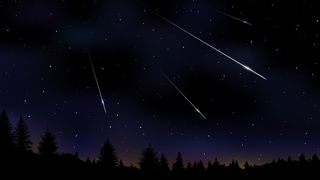Shattered comet could produce dazzling meteor shower: How to watch the tau Herculids
Scientists say the shower could be an “all or nothing” event

A once lost, crumbling comet could deliver a brand-new meteor shower to Earth next week.
The shower, which has been called the tau Herculids, is set to fall from the shattered SW3 comet beginning May 30 and peaking on May 31 between 12:45 p.m. and 01:17 a.m. EDT, lighting up skies across the U.S. and parts of Canada with some brief but bright streaks of flame.
NASA astronomer Bill Cooke described the comet’s possible upcoming appearance in a NASA statement as an "all or nothing event." The show would be the result of debris cast off from a fragment of the comet. While comet debris most often falls behind the comet fragment to form the tail, sometimes it can get expelled at such a high velocity that the bits of ice and rock are slingshotted ahead of the comet. For us to see this debris as it burns up in our atmosphere it has to be either big enough or fast enough to burn brightly as our planet treks through its path, according to the American Meteor Society (AMS).
Related: Why are asteroids and comets such weird shapes?
“If the debris from SW3 was traveling more than 220 miles per hour [354 km/h] when it separated from the comet, we might see a nice meteor shower,” Cooke said. “If the debris had slower ejection speeds, then nothing will make it to Earth and there will be no meteors from this comet.”
The SW3, or the 73P/Schwassmann-Wachmann, comet was named after its discoverers, the German astronomers Arnold Schwassmann and Arno Arthur Wachmann. The pair first found and cataloged SW3 in 1930, confirming from orbital observations that it was on a 5.4-year orbit. At its closest visit on May 31, 1931, the comet was just 5.7 million miles (9.2 million kilometers) away from Earth, but it was fairly dim and could only be seen through telescopes.
Then, in 1935, the comet disappeared from sight, coming and going eight times without being seen until it was finally spotted again in 1979. The comet remained faint until its 1995 flyby, when it returned nearly 400 times as bright and visible to the naked eye. Further investigation soon revealed that SW3’s brightness was owed to a stunning transformation — its icy core had fractured into four fragments, and by 2006 the shattered comet had split into 68 pieces. It has likely continued to break down even further in the 16 years since.
Sign up for the Live Science daily newsletter now
Get the world’s most fascinating discoveries delivered straight to your inbox.
The best locations to spot the meteor shower will be in the Southwest, the AMS said.
"The southwestern USA and Mexico are favored locations as the radiant, the area of the sky where these meteors come from, will be located highest in a dark sky," Robert Lunsford wrote on the society’s blog. "Alaska and Washington will be bathed in twilight at this time, ruining their chance of seeing anything. The same goes for the north and western Canadian provinces.The outburst may be seen from southeastern Canada and the remainder of the (eastern) USA, but at a lower altitude."
The best place to look for the comet is the constellation Boötes, which is just next to the star Arcturus, according to EarthSky. Additionally, as the moon will be in a new phase, the sky will be dark, making potential viewing easier. The darkest possible viewing space is recommended for spotting this shower, as many of its smaller chunks will be slow moving — meaning that they will burn dimly and may not be visible. As the display could also contain larger fragments, however, there’s a chance the shower could include some stunning slow-moving fireballs.
"If it makes it to us this year, the debris from SW3 will strike Earth's atmosphere very slowly, traveling at just 10 miles [16 km] per second — which means much fainter meteors than those belonging to the eta Aquariids," NASA wrote in its blog post.
Originally published on Live Science.

Ben Turner is a U.K. based staff writer at Live Science. He covers physics and astronomy, among other topics like tech and climate change. He graduated from University College London with a degree in particle physics before training as a journalist. When he's not writing, Ben enjoys reading literature, playing the guitar and embarrassing himself with chess.
